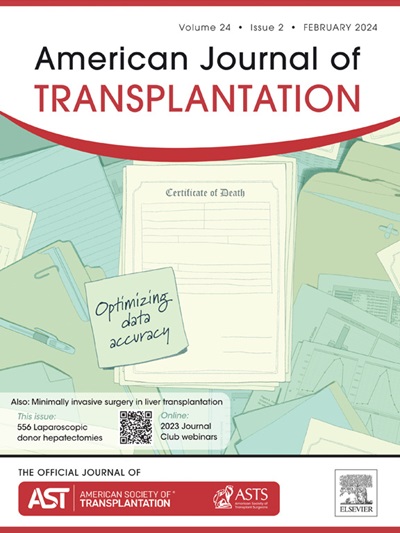Association of the Initial Implementation of Continuous Distribution Allocation Policy with Outcomes for Lung Transplant Candidates by Blood Type.
IF 8.9
2区 医学
Q1 SURGERY
引用次数: 0
Abstract
On 3/9/2023, allocation of donor lungs in the US changed to continuous distribution(CD). Initial implementation of policy was flawed due to a programming error affecting priority of candidates by blood type. While this issue was identified and addressed, the impact of initial policy implementation on blood type O candidates has not been rigorously evaluated. We used SRTR data to evaluate candidate(n=4,738) and recipient(n=4,437) outcomes following CD policy. Using cumulative incidence plots accounting for competing risks and multivariable Cox models, incidence of transplantation pre-policy was similar by blood type (8-month incidence 81.0% vs. 80.5% for blood types-A,B,AB and blood type-O respectively,p=0.57). Following CD policy, blood type-O candidates had lower incidence of transplantation relative to other blood types (8-month incidences 86.3% vs 92.1% respectively,p<0.001) with a significantly lower adjusted hazard ratio(AHR) for transplantation (AHR=0.67,95% C.I. 0.54-0.82). Blood type-O candidates were more likely Hispanic and 'Other' race and had higher rates of waitlist removal or death following CD (6.0% vs 2.9%,p=0.003). Among transplants performed prior to CD, 48% were blood type-O recipients compared to 40% post-CD, representing 138 fewer blood type-O transplants than expected. Type-O blood candidates had significant decline in prognosis relative to other blood groups following initial implementation of CD policy.连续分配政策的初步实施与血型肺移植候选者预后的关系。
2023 年 9 月 3 日,美国的捐肺分配改为连续分配(CD)。由于程序错误影响了血型候选者的优先权,政策的初步实施存在缺陷。虽然这一问题已被发现并解决,但最初政策的实施对 O 型血候选人的影响尚未得到严格评估。我们使用 SRTR 数据评估了 CD 政策实施后候选者(4738 人)和受者(4437 人)的结果。使用累积发病率图(考虑竞争风险)和多变量 Cox 模型,不同血型在政策实施前的移植发病率相似(A、B、AB 和 O 型血的 8 个月发病率分别为 81.0% 和 80.5%,P=0.57)。CD 政策实施后,O 型血患者的移植发生率低于其他血型(8 个月的发生率分别为 86.3% 与 92.1%,p<0.001),移植的调整危险比(AHR)显著降低(AHR=0.67,95% C.I.0.54-0.82)。血型为O型的患者更可能是西班牙裔和 "其他 "种族,而且在CD后的候选名单中除名或死亡的比例更高(6.0% vs 2.9%,p=0.003)。在 CD 之前进行的移植中,48% 的受者为 O 型血,而 CD 之后为 40%,O 型血的移植数量比预期少 138 例。在最初实施 CD 政策后,O 型血候选人的预后相对于其他血型明显下降。
本文章由计算机程序翻译,如有差异,请以英文原文为准。
求助全文
约1分钟内获得全文
求助全文
来源期刊
CiteScore
18.70
自引率
4.50%
发文量
346
审稿时长
26 days
期刊介绍:
The American Journal of Transplantation is a leading journal in the field of transplantation. It serves as a forum for debate and reassessment, an agent of change, and a major platform for promoting understanding, improving results, and advancing science. Published monthly, it provides an essential resource for researchers and clinicians worldwide.
The journal publishes original articles, case reports, invited reviews, letters to the editor, critical reviews, news features, consensus documents, and guidelines over 12 issues a year. It covers all major subject areas in transplantation, including thoracic (heart, lung), abdominal (kidney, liver, pancreas, islets), tissue and stem cell transplantation, organ and tissue donation and preservation, tissue injury, repair, inflammation, and aging, histocompatibility, drugs and pharmacology, graft survival, and prevention of graft dysfunction and failure. It also explores ethical and social issues in the field.

 求助内容:
求助内容: 应助结果提醒方式:
应助结果提醒方式:


